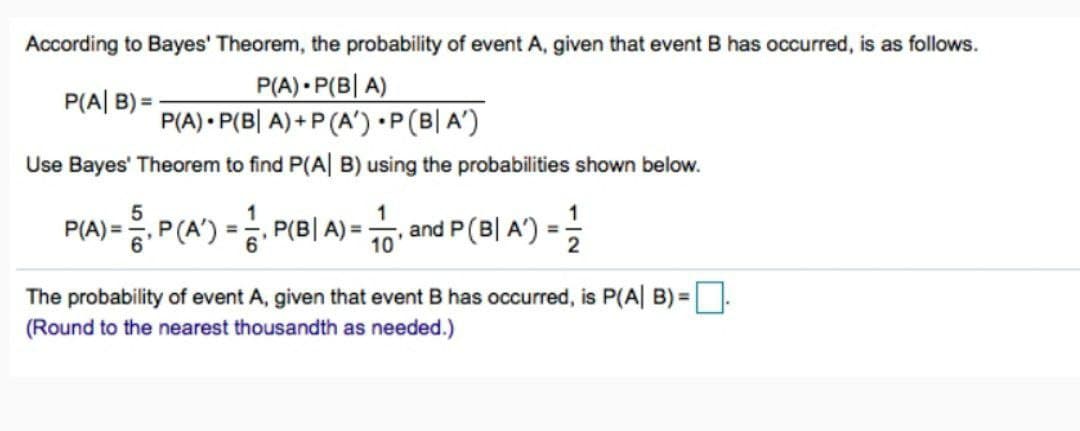According to Bayes' Theorem, the probability of event A, given that event B has occurred, is as follows. P(A) P(BA) P(A|B)= P(A) P(BA)+P(A') · P(B|A') Use Bayes' Theorem to find P(A| B) using the probabilities shown below. 1 P(A) = P(A) = P(B| A)= , and P (B| A') = = 10' The probability of event A, given that event B has occurred, is P(A|B)= ☐ (Round to the nearest thousandth as needed.)
According to Bayes' Theorem, the probability of event A, given that event B has occurred, is as follows. P(A) P(BA) P(A|B)= P(A) P(BA)+P(A') · P(B|A') Use Bayes' Theorem to find P(A| B) using the probabilities shown below. 1 P(A) = P(A) = P(B| A)= , and P (B| A') = = 10' The probability of event A, given that event B has occurred, is P(A|B)= ☐ (Round to the nearest thousandth as needed.)
Holt Mcdougal Larson Pre-algebra: Student Edition 2012
1st Edition
ISBN:9780547587776
Author:HOLT MCDOUGAL
Publisher:HOLT MCDOUGAL
Chapter11: Data Analysis And Probability
Section11.8: Probabilities Of Disjoint And Overlapping Events
Problem 2C
Related questions
Question
None

Transcribed Image Text:According to Bayes' Theorem, the probability of event A, given that event B has occurred, is as follows.
P(A) P(BA)
P(A|B)=
P(A) P(BA)+P(A') · P(B|A')
Use Bayes' Theorem to find P(A| B) using the probabilities shown below.
1
P(A) = P(A) = P(B| A)=
, and P (B| A') =
=
10'
The probability of event A, given that event B has occurred, is P(A|B)= ☐
(Round to the nearest thousandth as needed.)
Expert Solution
This question has been solved!
Explore an expertly crafted, step-by-step solution for a thorough understanding of key concepts.
Step by step
Solved in 2 steps with 1 images

Recommended textbooks for you

Holt Mcdougal Larson Pre-algebra: Student Edition…
Algebra
ISBN:
9780547587776
Author:
HOLT MCDOUGAL
Publisher:
HOLT MCDOUGAL

Elementary Linear Algebra (MindTap Course List)
Algebra
ISBN:
9781305658004
Author:
Ron Larson
Publisher:
Cengage Learning

Algebra & Trigonometry with Analytic Geometry
Algebra
ISBN:
9781133382119
Author:
Swokowski
Publisher:
Cengage

Holt Mcdougal Larson Pre-algebra: Student Edition…
Algebra
ISBN:
9780547587776
Author:
HOLT MCDOUGAL
Publisher:
HOLT MCDOUGAL

Elementary Linear Algebra (MindTap Course List)
Algebra
ISBN:
9781305658004
Author:
Ron Larson
Publisher:
Cengage Learning

Algebra & Trigonometry with Analytic Geometry
Algebra
ISBN:
9781133382119
Author:
Swokowski
Publisher:
Cengage